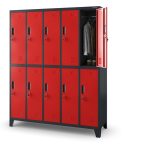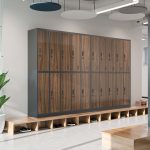In a gym, lockers are essential facilities that offer members a secure and convenient place to store personal items. The sizes of the lockers are a crucial part of their design and selection, as they need to meet storage requirements while ensuring efficient use of space. This article will discuss the average sizes of gym lockers, helping you understand the space requirements of different types of lockers and providing design references for your gym.
Common Sizes of Gym Lockers
The sizes of gym lockers vary depending on the region, design style, and intended use. Most locker designs aim to meet the basic storage needs of typical gym members. The common sizes of gym lockers are as follows:
1. Single-door Lockers
Single-door lockers are the most common type, typically used for storing personal items such as clothes, shoes, and small personal belongings. Below are the common sizes for single-door lockers:
Height: Typically ranges from 1.8 meters to 2 meters. This height suits most adults and allows for storing long clothes.
Width: Generally between 30 cm and 45 cm. This width is enough to store backpacks, shoes, jackets, and other items.
Depth: The depth is usually between 35 cm and 50 cm, ensuring that members can easily place clothes and personal items without feeling cramped.

2. Multi-door Lockers
Multi-door lockers consist of several independent storage units, suitable for gyms with a larger number of members or varying storage needs. The sizes of each unit within the multi-door locker may differ. Below are the common sizes for multi-door locker units:
Height: Similar to single-door lockers, each unit in a multi-door locker typically has a height of 1.8 meters to 2 meters.
Width: The width of each unit is generally between 30 cm and 40 cm, meaning multiple smaller storage units can effectively maximize space.
Depth: The depth is usually between 35 cm and 45 cm, adequate for storing clothes, shoes, and other everyday items.
In some high-end gyms, designers may create larger units to accommodate more or larger personal items based on actual needs.

3. Specialized Lockers (Large Lockers)
For high-end gyms or facilities with specific requirements (such as those with saunas, steam rooms, or swimming pools), members may need larger storage spaces to store more complex personal items. These lockers are generally larger:
Height: Typically between 1.8 meters and 2 meters, consistent with standard locker height.
Width: The width is usually between 45 cm and 60 cm, allowing for the storage of larger items such as gym bags, racquets, and shoes.
Depth: The depth can reach between 50 cm and 60 cm, suitable for storing longer or bulkier items.
Impact of Locker Sizes on Gym Design
The size of lockers affects not only their storage capacity but also the gym's space utilization. When designing a gym, the following factors are important to consider when choosing locker sizes:
1. Space Utilization
Lockers need to be appropriately placed near gym entrances, changing rooms, or other suitable locations. Choosing the right size maximizes the use of limited space and avoids waste. Smaller lockers are ideal for small gyms or facilities with fewer members, while larger lockers suit larger gyms.
2. Member Needs
Understanding the storage needs of gym members is crucial when selecting locker sizes. For instance, if most members bring gym bags or other large items, choosing lockers with greater width and depth would be more suitable. On the other hand, if members primarily store clothes and small items, standard-sized lockers will suffice.
3. Cost Considerations
The sizes of lockers directly affect the cost of production, installation, and maintenance. Larger lockers are typically more expensive, and they require more space to install, so if the budget is limited, selecting standard-sized single-door lockers may be a more cost-effective option.
Considerations When Choosing Gym Lockers Sizes
When selecting gym locker sizes, consider the following factors:
1. Security
Ensure that the locker locks are secure and reliable, effectively protecting members' valuable belongings. Whether it is a single-door locker or a multi-door locker, high-quality locks should be installed to avoid potential security risks.
2. Ventilation
To prevent moisture and odors inside lockers, good ventilation design is essential. Modern lockers usually feature ventilation holes or use breathable materials to help air circulate and keep the interior dry and fresh.
3. Design Style
The design of the lockers should match the overall aesthetic of the gym. For example, a modern minimalist gym might choose metal or wooden lockers, while a high-end gym might opt for more luxurious locker designs.
Conclusion
The sizes of gym lockers vary depending on the specific needs and space design of the gym. When designing and selecting lockers, it is important to consider the actual situation of the gym, the needs of the members, and the budget to determine the best solution.




